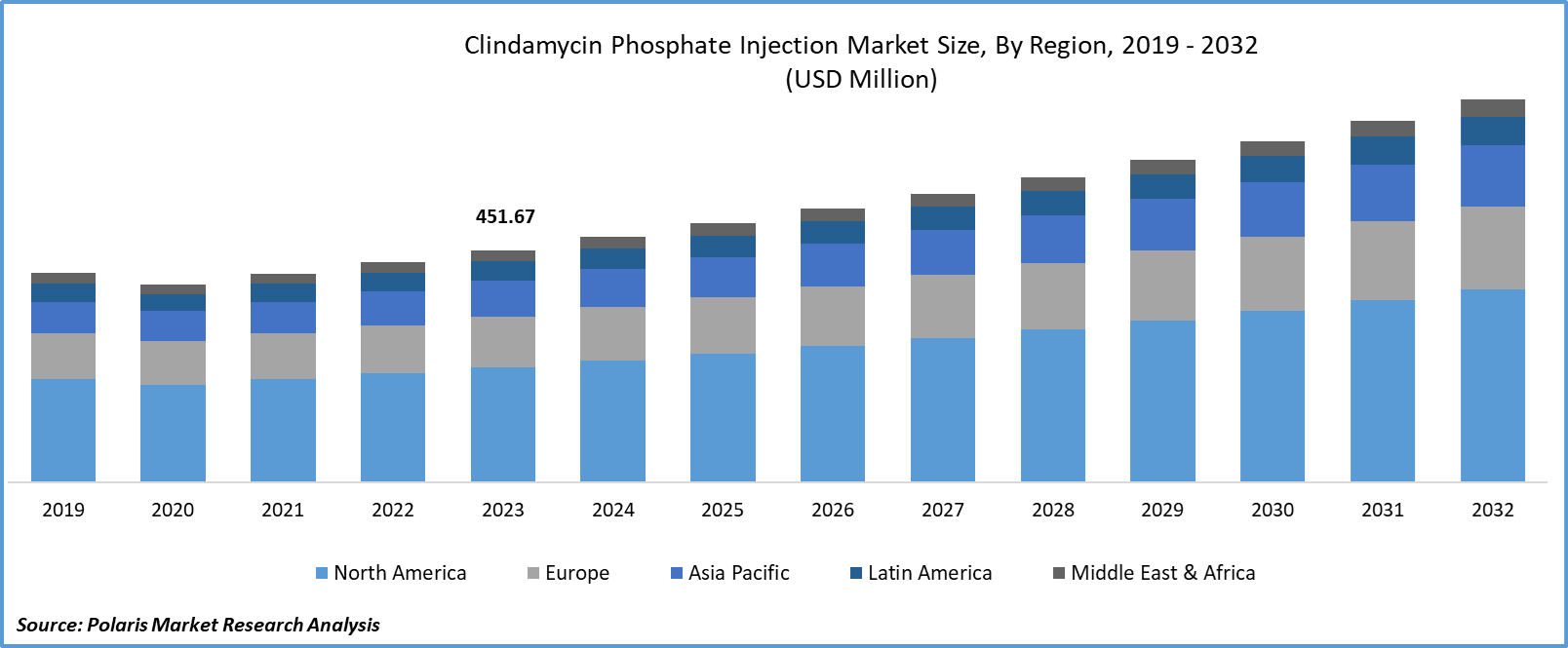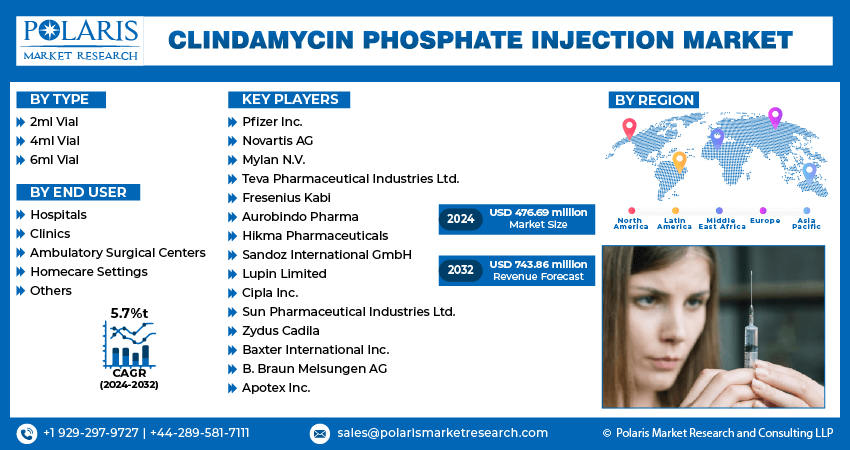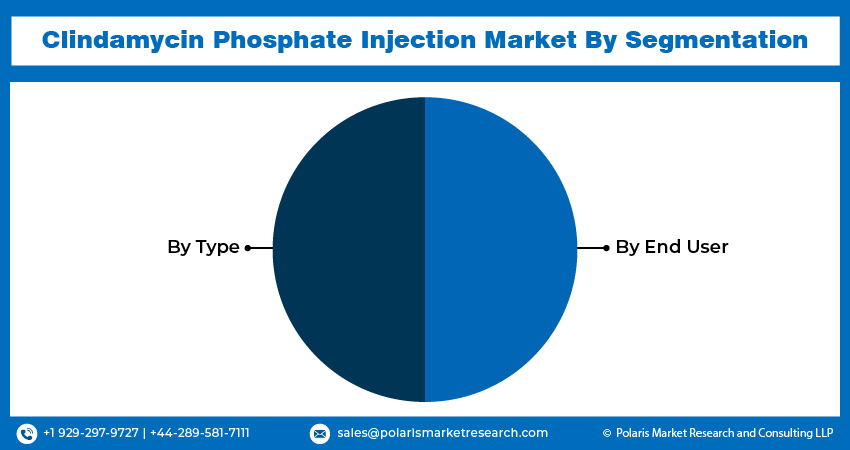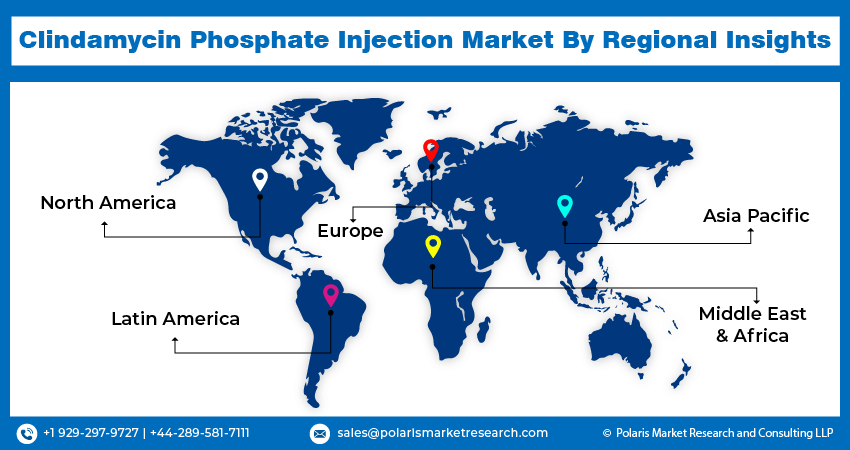
Clindamycin Phosphate Injection Market Size, Share, Trends, Industry Analysis Report: By Type (2ml Vial, 4ml Vial, and 6ml Vial), By End User, and By Region (North America, Europe, Asia Pacific, Latin America, and Middle East & Africa) – Market Forecast, 2024 - 2032
- Published Date:Sep-2024
- Pages: 119
- Format: PDF
- Report ID: PM5049
- Base Year: 2023
- Historical Data: 2019-2022
Clindamycin Phosphate Injection Market Overview
Global clindamycin phosphate injection market size was valued at USD 451.67 million in 2023. The market is projected to grow from USD 476.69 million in 2024 to USD 743.86 million by 2032, exhibiting a CAGR of 5.7% during the forecast period.
The clindamycin phosphate injection market involves the supply and demand for injectable forms of clindamycin, an antibiotic used to treat serious infections caused by bacteria. It includes various formulations and is influenced by trends in infection control and healthcare. The global clindamycin phosphate injection market is experiencing significant growth, driven by increasing demand for effective antibiotics in treating bacterial infections, particularly in hospital settings. Key drivers include the rising incidence of bacterial infections, especially in immunocompromised patients, and the growing prevalence of skin and soft tissue infections that require potent antibiotic treatment. Additionally, the market is influenced by the trend toward the development of combination therapies and the increasing adoption of clindamycin phosphate in treating antibiotic-resistant infections. The expanding healthcare infrastructure in emerging markets also contributes to the market's growth, offering new opportunities for manufacturers.

To Understand More About this Research:Request a Free Sample Report
Clindamycin Phosphate Injection Market Trends
Increasing Focus on Combating Antibiotic Resistance
As bacterial resistance to commonly used antibiotics continues to rise, healthcare providers are seeking alternative treatments like clindamycin phosphate, which remains effective against a broad range of resistant bacteria. This trend is particularly evident in hospital settings, where antibiotic-resistant infections are more prevalent. The need for potent antibiotics that can treat these resistant strains is driving the demand for clindamycin phosphate injections, positioning them as a crucial tool in the fight against superbugs.
Growing Adoption of Clindamycin Phosphate Injection in Emerging Markets
The clindamycin phosphate injection market is witnessing growing adoption of these injections in emerging markets, fueled by the expansion of healthcare infrastructure and increased access to medical treatments. In regions such as Asia Pacific and Latin America, the rising prevalence of bacterial infections, coupled with improving healthcare facilities, is leading to greater use of clindamycin phosphate injections. Governments and healthcare organizations in these areas are also prioritizing the availability of essential antibiotics to manage infectious diseases effectively. This trend not only expands the market reach of clindamycin phosphate but also highlights the increasing importance of global healthcare access.
Development of Combination Therapies
Pharmaceutical companies are increasingly exploring the potential of clindamycin phosphate in combination with other antibiotics to enhance efficacy and reduce the risk of resistance. These combination therapies are particularly beneficial in treating complex infections that involve multiple bacterial strains. By combining clindamycin phosphate with other antibiotics, healthcare providers can offer more comprehensive treatment options, improving patient outcomes and broadening the therapeutic applications of clindamycin phosphate. This trend is expected to drive innovation and growth in the market as new combination therapies are developed and introduced.

Clindamycin Phosphate Injection Market Segment Insights
Clindamycin Phosphate Injection Market Breakdown by Type Insights
The clindamycin phosphate injection market is segmented by type into 2ml Vial, 4ml Vial, and 6ml Vial. Among these, the 2ml Vial segment currently dominates the market, owing to its widespread use in clinical settings for treating a variety of infections, including skin and soft tissue infections. The smaller dosage volume makes it a preferred choice for short-term treatments, especially in outpatient settings where ease of administration and dosage accuracy are crucial. Additionally, the 2ml Vial's dominance is supported by its cost-effectiveness, making it accessible to a broader range of healthcare providers and patients.
The 6ml Vial segment is also expected to witness the highest growth rate during the forecast period. This growth is driven by the increasing demand for higher dosage forms in severe or resistant bacterial infections, which require prolonged or more intensive treatment regimens. The 6ml Vial is particularly gaining traction in hospital environments, where it is used for serious infections that necessitate larger and more sustained doses of clindamycin phosphate. As the healthcare industry continues to focus on effectively managing complex bacterial infections, the demand for higher-volume vials like the 6ml variant is anticipated to rise, contributing to the segment's rapid growth.
Clindamycin Phosphate Injection Market End User Insights
The clindamycin phosphate injection market is segmented by end user into hospitals, clinics, ambulatory surgical centers, homecare settings, and others. Among these, the hospitals segment dominates the market, largely due to the high incidence of bacterial infections in hospital settings, where the need for potent antibiotics like clindamycin phosphate is critical. Hospitals are primary centers for treating severe and complicated infections, often requiring intravenous administration of antibiotics. Also, the ability to manage serious infections, particularly in immunocompromised patients and those with antibiotic-resistant bacteria, makes hospitals the largest consumers of clindamycin phosphate Injections.
The homecare settings segment is expected to be the fastest-growing sector during the forecast period. This growth is driven by the rising trend of outpatient care and the increasing preference for home-based treatment, especially for chronic infections requiring long-term antibiotic therapy. Advances in homecare services, coupled with the availability of portable infusion devices, have made it easier for patients to receive clindamycin phosphate injections at home, reducing the need for hospital stays. As healthcare systems globally emphasize reducing hospital readmissions and cutting healthcare costs, the demand for homecare administration of antibiotics is anticipated to rise, driving significant growth in this segment.
Global Clindamycin Phosphate Injection Market, Segmental Coverage, 2019 - 2032 (USD million)

Source: Secondary Research, Primary Research, PMR Database and Analyst Review
Clindamycin Phosphate Injection Market Breakdown by Regional Insights
By region, the study provides market insights into North America, Europe, the Asia Pacific, Latin America, and the Middle East & Africa. According to a regional analysis, North America is the leading region in the clindamycin phosphate injection market. This is mostly because of the region’s sophisticated healthcare system, high rate of bacterial infections, and concentration of significant pharmaceutical businesses. The region's well-established healthcare systems, coupled with significant investments in research and development, have facilitated widespread use of clindamycin phosphate injections, particularly in hospital settings. Additionally, the rising incidence of antibiotic-resistant infections in the U.S. and Canada has further driven the demand for effective antibiotics like clindamycin phosphate. Furthermore, Europe and the Asia Pacific are also notable regions, with Asi -Pacific expected to witness substantial growth due to expanding healthcare access and rising infection rates.
Global Clindamycin Phosphate Injection Market, Regional Coverage, 2019 - 2032 (USD million)

Source: Secondary Research, Primary Research, PMR Database and Analyst Review
The clindamycin phosphate injection market in Europe is growing steadily, driven by the increasing incidence of bacterial infections and the rising awareness of antibiotic resistance. The region's robust healthcare infrastructure, particularly in countries such as Germany, the UK, and France, supports the widespread use of clindamycin phosphate injections in both hospitals and clinics. Additionally, Europe has a strong regulatory framework that encourages the adoption of effective antibiotics to combat resistant bacterial strains, further boosting market growth.
The Asia Pacific region is experiencing rapid growth in the clindamycin phosphate injection market, fueled by the increasing prevalence of bacterial infections and the expanding healthcare infrastructure in emerging economies such as China, India, and Southeast Asian countries. The rising population, coupled with improving access to healthcare services, has led to a higher demand for effective antibiotics, including clindamycin phosphate. Additionally, the growing awareness of antibiotic resistance and the need for potent treatments in both urban and rural areas are driving market growth. The Asia Pacific is also benefiting from increased investment in healthcare and pharmaceutical industries, making it a key region for future market expansion.
Clindamycin Phosphate Injection Market Key Market Players & Competitive Insights
The clindamycin phosphate injection market features several key players who dominate the market with their extensive product offerings and strong distribution networks. Some of the prominent companies in this market include Pfizer Inc., Novartis AG, Mylan N.V., Teva Pharmaceutical Industries Ltd., Fresenius Kabi, Aurobindo Pharma, Hikma Pharmaceuticals, Sandoz International GmbH, Lupin Limited, Cipla Inc., Sun Pharmaceutical Industries Ltd., Zydus Cadila, Baxter International Inc., B. Braun Melsungen AG, and Apotex Inc. These companies are recognized for their robust portfolios of injectable antibiotics and their global reach, which allows them to serve a wide range of healthcare settings.
In terms of competitive analysis, Pfizer Inc. and Novartis AG are among the major players, leveraging their strong research and development capabilities to innovate and expand their product lines. Pfizer's established presence in the antibiotic market and Novartis's strategic focus on high-quality injectable drugs give them a competitive edge. Mylan N.V. and Teva Pharmaceutical Industries Ltd. are also significant players, known for their extensive generics portfolios, which include clindamycin phosphate injections at competitive pricing. Fresenius Kabi and Hikma Pharmaceuticals are particularly strong in the hospital segment, where they supply injectable antibiotics to healthcare institutions worldwide. These companies compete on the basis of product quality, pricing, and distribution capabilities.
Insights from the competitive landscape reveal that the market is highly fragmented, with both multinational pharmaceutical giants and regional players competing for market share. Companies are increasingly focusing on expanding their production capacities and enhancing their distribution networks to meet the growing demand, particularly in emerging markets. The market also sees significant competition in terms of pricing strategies, with generic manufacturers offering cost-effective alternatives to branded products. Additionally, strategic partnerships, mergers, and acquisitions are common as companies seek to strengthen their market positions and expand their geographical footprint. As the demand for effective antibiotics continues to rise, particularly in the fight against resistant bacterial strains, key players are expected to intensify their efforts in innovation, quality improvement, and market expansion.
Pfizer Inc. is one of the significant players in the clindamycin phosphate injection market, known for its extensive portfolio of antibiotics and strong global presence. It's long-standing expertise in pharmaceutical research and development has positioned it as a key provider of high-quality injectable antibiotics, including clindamycin phosphate. The company focuses on delivering effective treatments for bacterial infections, particularly in hospital settings where the need for potent antibiotics is critical. A recent highlight for Pfizer is its continuous efforts to expand its portfolio through strategic partnerships and acquisitions, aiming to strengthen its position in the injectable antibiotics market.
Novartis AG is another major player in the clindamycin phosphate injection market, with a strong emphasis on producing high-quality generic and branded pharmaceuticals. Its focus on innovation and quality has made it a preferred choice among healthcare providers for treating bacterial infections. The company is also active in expanding its product offerings and market reach through strategic investments in research and development.
List of Key Companies in Clindamycin Phosphate Injection Market
- Pfizer Inc.
- Novartis AG
- Mylan N.V.
- Teva Pharmaceutical Industries Ltd.
- Fresenius Kabi
- Aurobindo Pharma
- Hikma Pharmaceuticals
- Sandoz International GmbH
- Lupin Limited
- Cipla Inc.
- Sun Pharmaceutical Industries Ltd.
- Zydus Cadila
- Baxter International Inc.
- B. Braun Melsungen AG
- Apotex Inc.
Clindamycin Phosphate Injection Industry Developments
- June 2024: Novartis announced a partnership to enhance its injectable drug production capabilities, reinforcing its commitment to meeting the growing demand for antibiotics like Clindamycin Phosphate.
Clindamycin Phosphate Injection Market Segmentation
By Type Outlook, (Revenue USD million, 2019–2032)
- 2ml Vial
- 4ml Vial
- 6ml Vial
By End User Outlook, (Revenue USD million, 2019–2032)
- Hospitals
- Clinics
- Ambulatory Surgical Centers
- Homecare Settings
- Others
By Regional Outlook, (Revenue USD million, 2019–2032)
- North America
- US
- Canada
- Europe
- Germany
- France
- UK
- Italy
- Spain
- Netherlands
- Russia
- Rest of Europe
- Asia Pacific
- China
- Japan
- India
- Malaysia
- South Korea
- Indonesia
- Australia
- Vietnam
- Rest of Asia Pacific
- Middle East & Africa
- Saudi Arabia
- UAE
- Israel
- South Africa
- Rest of Middle East & Africa
- Latin America
- Mexico
- Brazil
- Argentina
- Rest of Latin America
Clindamycin Phosphate Injection Report Scope
|
Report Attributes |
Details |
|
Market Size Value in 2023 |
USD 451.67 million |
|
Market Size Value in 2024 |
USD 476.69 million |
|
Revenue Forecast in 2032 |
USD 743.86 million |
|
CAGR |
5.7% from 2024 to 2032 |
|
Base Year |
2023 |
|
Historical Data |
2019 – 2022 |
|
Forecast Period |
2024 – 2032 |
|
Quantitative Units |
Revenue in USD million and CAGR from 2024 to 2032 |
|
Report Coverage |
Revenue Forecast, Market Competitive Landscape, Growth Factors, and Trends |
|
Segments Covered |
|
|
Regional Scope |
|
|
Competitive Landscape |
|
|
Report Format |
|
|
Customization |
Report customization as per your requirements with respect to countries, regions, and segmentation. |
How the report is valuable for an organization?
Workflow/Innovation Strategy:
The clindamycin phosphate injection market has been segmented into detailed segments of types, end users, and regional segmentation.
Growth/Marketing Strategy:
To drive growth in the clindamycin phosphate injection market, companies are focusing on expanding their product portfolios and enhancing their distribution networks to reach diverse healthcare settings. Strategic partnerships and acquisitions are key components of their marketing strategy, enabling companies to access new markets and strengthen their competitive position. Additionally, investing in research and development to innovate and improve product formulations helps address emerging antibiotic resistance issues. Targeted marketing efforts in emerging economies, coupled with robust pricing strategies and enhanced customer engagement, are also crucial for capturing market share and meeting the increasing demand for effective antibacterial treatments.
FAQ's
The global clindamycin phosphate injection market size was valued at USD 451.67 million in 2023 and is projected to grow to USD 743.86 million by 2032.
The global market is projected to register a CAGR of 5.7% during the forecast period, 2023-2032.
North America had the largest share of the global market.
Some of the prominent companies in this market include Pfizer Inc., Novartis AG, Mylan N.V., Teva Pharmaceutical Industries Ltd., Fresenius Kabi, Aurobindo Pharma, Hikma Pharmaceuticals, Sandoz International GmbH, Lupin Limited, Cipla Inc., Sun Pharmaceutical Industries Ltd., Zydus Cadila, Baxter International Inc., B. Braun Melsungen AG, and Apotex Inc.
The 2ml Vial dominated the market in 2023.
The hospitals segment had the largest share of the global market.
Clindamycin phosphate injection is a sterile, intravenous form of the antibiotic clindamycin, which is used to treat a range of bacterial infections. Clindamycin is a lincosamide antibiotic that works by inhibiting bacterial protein synthesis, thereby stopping the growth of bacteria. The phosphate salt form, used in injections, allows for rapid and effective delivery of the drug directly into the bloodstream, making it suitable for treating severe infections where oral antibiotics might not be effective or appropriate.
Here are some key trends observed in this market: Rising Antibiotic Resistance: The increasing prevalence of antibiotic-resistant bacteria is driving demand for effective treatments like clindamycin phosphate, which remains potent against certain resistant strains. Expansion in Emerging Markets: Growing healthcare infrastructure and rising incidence of bacterial infections in emerging markets, such as Asia Pacific and Latin America, are fueling market growth. Development of Combination Therapies: Research into combination therapies involving clindamycin phosphate with other antibiotics is on the rise to enhance efficacy and combat complex infections. Shift Towards Homecare Settings: The trend towards outpatient and homecare settings for administering antibiotics is growing, supported by advancements in portable infusion technology.
For a new company entering the clindamycin phosphate injection market, focusing on several strategic areas can help stay ahead of the competition. Emphasizing innovation in drug delivery systems, such as developing advanced infusion technologies and improving product stability, can differentiate the company from existing players. Additionally, investing in research to explore combination therapies and address emerging antibiotic resistance issues will position the company as a leader in addressing complex infections. Expanding into rapidly growing emerging markets with tailored strategies and establishing strong partnerships with healthcare providers will also be crucial for capturing market share and ensuring long-term success.
Companies producing clindamycin phosphate injections and related products, healthcare providers, and other consulting firms should buy this report.
